
Eighth-grade students Laylee Burchell, Blake Turner and Hannah Harrison display their Civil War bullets during Sharon Graves’ 8th-grade American History class at Clark-Moores Middle School (Madison County). Each student in the class was assigned a bullet and wrote a narrative about it. Photo by Amy Wallot, Oct. 15, 2012
By Susan Riddell
susan.riddell@education.ky.gov
Blake Turner, an 8th grader at Clark Moores Middle School (Madison County), is flying through the air. He’s scared. He doesn’t want to hit anything or anyone. Luckily, he doesn’t.
Turner, in this case, is a bullet misfired just as the Battle of Perryville is getting underway back in the Civil War days. The bullet is thankful it didn’t hit anyone “but disappointed that I would not be able to help out my master at all.”
As the bullet’s journey comes to a close, it is retrieved by a man after being buried in the ground for 150 years “thinking and oxidizing.”
Turner’s narrative of a bullet is one of many in Sharon Graves’ social studies class, where students are studying the Civil War.
As part of their studies, students were given bullets from other Civil War battles like Gettysburg and Vicksburg. Graves has collected several of these from various trips, she said.
Some bullets were mangled, while others had teeth marks or were in mint condition. Students were told what type of bullet they had and where it was found.
They had to do basic research on the battle in which their bullet was used and incorporate it into their narrative, but creative writing also was an important element in the assignment.
“It required some research, but the rest was up to the individual student as to what could have possibly made that dent in their bullet or how a tooth print got into the musket ball,” Graves said. “I greatly enjoyed reading them, as no two papers resembled each other.”
This was the first time Graves had her students complete this project. She collaborated with language arts teachers for it and had English and language arts standards in mind when she came up with this assignment, in particular the reading standards for literacy in history/social studies, she said.
“For social studies I was looking at the economic aspect of factory produced bullets versus those made by the soldiers themselves,” Graves said. “The students also looked at the new technology of the Civil War, which produced more efficient weapons. I used historical perspective with a primary source and interactions among individuals and groups to discuss conflict.
Civil War history is included in the Program of Studies and Core Content for Assessment 4.1 for 8th grade, said Charles Hall, social studies consultant for the Kentucky Department of Education.
“Artifacts are examples of a form of primary sources that are encouraged to be utilized significantly in history/social studies, especially as we work to improve literacy in social studies,” Hall said.
“The analysis of primary sources, research, writing and communicating results are all part of our content literacy focus with history/social studies.”
Graves also has her 8th-grade students host Civil War Living History Days along with numerous re-enactors at the Battle of Richmond Park with students acting as tour guides and presenters.
In the early fall, students choose a Civil War topic to research from the time period. Some students are later chosen in the spring to present their research to area elementary kids during the festivities.
“Last year my kids taught about medicine, baseball, hot-air balloons and cemetery interpretation,” said Graves, who added that students would stay after school to hand-sew Civil War outfits to wear at the event.
Living history days are fairly common in schools across Kentucky as more teachers are giving students opportunities for hands-on and project-based learning.
Richard Ingraham, social studies chairman at Ockerman Middle School (Boone County), has hosted a similar spring event in northern Kentucky called Camp OMS: Civil War Day.
Ingraham’s event consists of 20-30 Civil War reenactors participating in living history stations
Stations included enlistment, African American troops, Abraham Lincoln, Frederick Douglass, medical/surgical, parlor etiquette, dance, artillery and cavalry, he said.
Even though these units tend to focus on the Civil War as a whole, they are timely because Kentucky is currently commemorating its Civil War Sesquicentennial. With 150 years since the state began to play a role in the war, Graves said it’s imperative students understand just how important Kentucky was in the war.
“If we do not educate our children about our unique history, it will be lost,” she said.
“Our Civil War battles were not as significant (in terms of casualties or battle length) as other states, but what happened here in Kentucky is important,” Graves added. “Kentucky was a state that President Lincoln could ill afford to lose. On numerous occasions he referred to the importance of the state and once is quoted as saying, ‘I hope to have God on my side, but I must have Kentucky.’”
Graves noted that Kentucky, as a border state in the war, also was important because of the horse industry, which provided horses to the war effort.
“People need to be made aware of what happened in our history,” Graves said. “This is our culture.”
MORE INFO …
Charles Hall, charles.hall2@education.ky.gov, (502) 564-2106
Sharon Graves, sharon.graves@madison.kyschools.us, (859) 624-4545








Leave A Comment